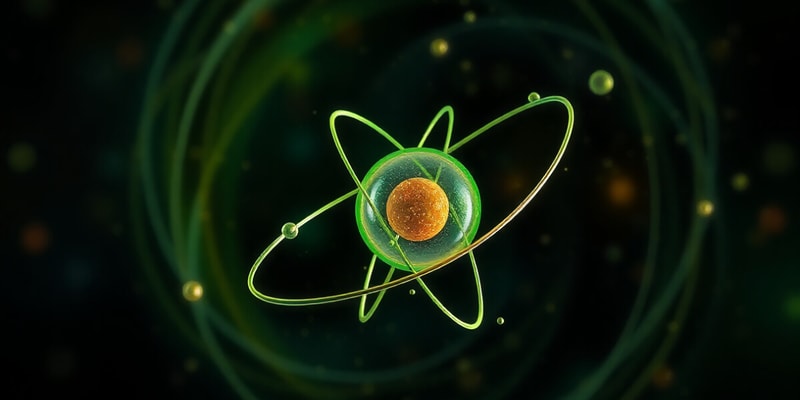Podcast
Questions and Answers
What is the significance of the wavefunction in describing atomic orbitals?
What is the significance of the wavefunction in describing atomic orbitals?
The wavefunction describes the probability distribution of an electron's position in an atom.
How does the principal quantum number (n) relate to the average distance of an electron from the nucleus?
How does the principal quantum number (n) relate to the average distance of an electron from the nucleus?
As the principal quantum number (n) increases, the average distance of an electron from the nucleus also increases.
What are the possible values for the azimuthal quantum number (l), and what do they represent?
What are the possible values for the azimuthal quantum number (l), and what do they represent?
The azimuthal quantum number (l) can have values from 0 to (n-1) and represents the subshells (s, p, d, f).
Define the spin quantum number (ms) and its possible values.
Define the spin quantum number (ms) and its possible values.
Signup and view all the answers
What is the relationship between the quantum numbers and determining electron configurations?
What is the relationship between the quantum numbers and determining electron configurations?
Signup and view all the answers
Why is the Heisenberg uncertainty principle important in understanding atomic structure?
Why is the Heisenberg uncertainty principle important in understanding atomic structure?
Signup and view all the answers
What do the magnetic quantum number (ml) values indicate within a subshell?
What do the magnetic quantum number (ml) values indicate within a subshell?
Signup and view all the answers
How do the concepts of subshells and orbitals relate to the structure of the periodic table?
How do the concepts of subshells and orbitals relate to the structure of the periodic table?
Signup and view all the answers
What distinguishes the different types of orbitals (s, p, d, f) based on quantum numbers?
What distinguishes the different types of orbitals (s, p, d, f) based on quantum numbers?
Signup and view all the answers
Explain the notation used for an electron's quantum numbers and how they are typically ordered.
Explain the notation used for an electron's quantum numbers and how they are typically ordered.
Signup and view all the answers
What is the formula for determining the number of d-orbitals in a d sublevel?
What is the formula for determining the number of d-orbitals in a d sublevel?
Signup and view all the answers
How many orbitals are in the f sublevel?
How many orbitals are in the f sublevel?
Signup and view all the answers
What integer values can the magnetic quantum number (ml) take for a p sublevel?
What integer values can the magnetic quantum number (ml) take for a p sublevel?
Signup and view all the answers
What is the maximum number of electrons that can occupy one s-orbital?
What is the maximum number of electrons that can occupy one s-orbital?
Signup and view all the answers
Explain why a d subshell's energy level is higher than an s subshell's energy level in multi-electron atoms.
Explain why a d subshell's energy level is higher than an s subshell's energy level in multi-electron atoms.
Signup and view all the answers
What distinguishes the orientation of s-orbitals compared to p-orbitals?
What distinguishes the orientation of s-orbitals compared to p-orbitals?
Signup and view all the answers
Define the concept of paired electron spins in an orbital.
Define the concept of paired electron spins in an orbital.
Signup and view all the answers
What is the significance of the effective nuclear charge in electron configuration?
What is the significance of the effective nuclear charge in electron configuration?
Signup and view all the answers
Describe the probability distribution of an electron in a 1s orbital.
Describe the probability distribution of an electron in a 1s orbital.
Signup and view all the answers
How do the sizes of s-orbitals vary across different shells?
How do the sizes of s-orbitals vary across different shells?
Signup and view all the answers
Study Notes
Orbitals and Bonding
- Electrons are not discrete particles, they have wavelike properties.
- Heisenberg's uncertainty principle states that it is impossible to pinpoint the precise location of an electron.
- The wavefunction summarizes where an electron is likely to be found.
- Atomic orbital = the wavefunction of an electron in an atom.
- Atomic orbitals represent the region in space where there is a high probability of finding an electron.
- Atomic orbitals are defined by three quantum numbers:
- Principal (n): labels the shell, average distance of an electron from the nucleus increases as n increases.
- Azimuthal (l): labels the subshell (s, p, d, f)
- Magnetic (ml): labels orbitals of the subshells
- Spin-magnetic (ms): +½, –½ - labels spin state of electrons within orbitals.
- All orbitals with the same value of n belong to the same shell.
Electron Spin
- Electrons have two spin states, represented by ↑ (up) and ↓ (down).
- The spin states are distinguished by the fourth quantum number (spin magnetic), ms.
- ms can have only two values:
- +½ for an ↑ electron
- –½ for a ↓ electron.
Electronic Configurations – Quantum Numbers
- Each electron surrounding the nucleus of an element can be assigned a set of four unique quantum numbers in the order: n, l, ml, ms.
- Quantum numbers describe the properties of electrons and their behavior.
Principal Quantum Number (n)
- Labels the shell (energy level).
- Possible values are natural numbers excluding 0: 1, 2, 3, …
- Except for d-orbitals, the shell number matches the row of the periodic table.
Azimuthal Quantum Number (l)
- Labels the subshell (s, p, d, f).
- Possible values are natural numbers including 0 up to (n – 1): 0, 1, 2, ….(n – 1).
- Each subshell can contain multiple orbitals.
- 0 = s-orbital in the s-sublevel
- 1 = p-orbitals in the p-sublevel
- 2 = d-orbitals in the d-sublevel
- 3 = f-orbitals in the f-sublevel
Magnetic Quantum Number (ml)
- Labels specific orbitals within a subshell.
- Possible values are integers between and including –l and +l: –l, –l + 1, ….,+l – 1 +l.
- Each orbital can hold a maximum of two electrons.
- l = 0 (s): 2 e– in one s-orbital (ml = 0)
- l = 1 (p): 2 e– in each of three p-orbitals:
- (px (ml = –1), py (ml = 0), pz (ml = +1))
- l = 2 (d): 2 e– in each of five d-orbitals:
- (dxy (ml = –2), dxz (ml = –1), dyz (ml = 0), dx2 – y2 (ml = +1), dz2 (ml = +2))
Spin Magnetic Quantum Number (ms)
- Labels electron spin.
- Possible values are two rational numbers: +½, –½.
- Electron spin pairs in any one orbital must be opposite (one ↑ and one ↓).
Orbital Energies
- Electron-electron repulsions cause the energy of a d subshell to be higher than a s subshell of the next higher shell.
- s electrons are found closer to the nucleus, penetrating the electron cloud, allowing them to experience a higher effective nuclear charge.
- Shielding effect: Electrons shield each other from the full attraction of the nucleus, reducing the effective nuclear charge.
- Paired spins are denoted ↑↓.
- No two electrons in an atom can have the same set of four quantum numbers (Pauli Exclusion Principle).
s-Orbitals
- Spherical in shape.
- One s-orbital per shell.
- The boundary surface of the orbital is about a 90% probability of finding the electron.
- All s-orbitals are spherical in shape but differ in size: 1s > 2s > 3s.
Studying That Suits You
Use AI to generate personalized quizzes and flashcards to suit your learning preferences.
Related Documents
Description
Explore the fascinating concepts of atomic orbitals and electron spin in this chemistry quiz. Understand how wavefunctions, quantum numbers, and the uncertainty principle play crucial roles in determining the behavior of electrons in atoms. Test your knowledge and deepen your grasp of these fundamental topics.



